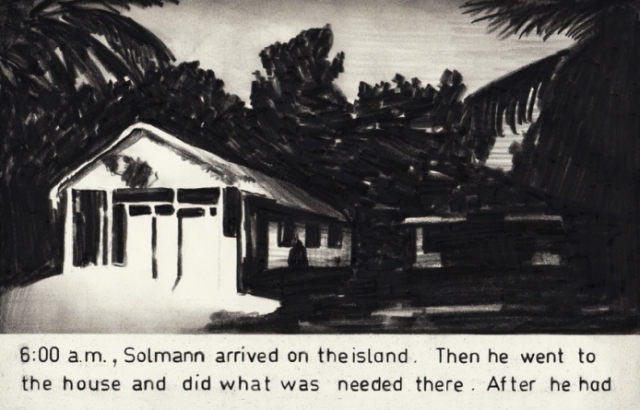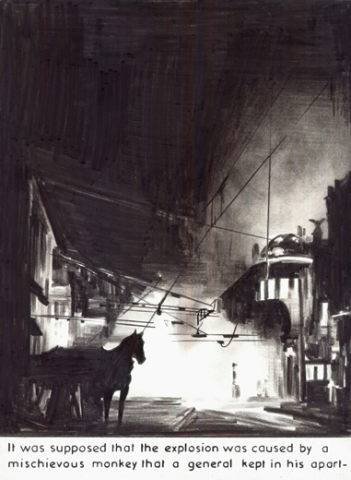Marcel van Eeden, Sprueth Magers London | reviews, news & interviews
Marcel van Eeden, Sprueth Magers London
Marcel van Eeden, Sprueth Magers London
Seeing things in black and white: a film noir drawn in pencil
An article in this week's New Yorker bemoans the death of drawing in art. Why has the emphasis on craft, Adam Gopnik writes, been replaced by concept? He has evidently not seen the fantastic noirish drawings of Marcel van Eeden at Sprueth Magers in Mayfair.
Van Eeden has created a mysterious story based around three characters - an athlete, an assassin and an artist - who meet on 22 November, 1948, the title of the show. There is murder in the Seychelles, a tram accident in Zurich, maps and guns and explosions, a complex plot which we can only ever see fragments of in his drawings. The Third Man plays a key role - it was also set in postwar Switzerland, with three mysterious men moving through the shadows - as does a murder that occurred during World War Two when the Duke of Windsor was in the Caribbean (hinted at in the picture below).
 Working almost entirely in nero pencil, which gives a waxy yet deep sheen, an almost comic-book chiaroscuro, Van Eeden hitches his world to ours by use of archive photos and text, which he repurposes to be part of his story, removing all the names and specific indicators. His fictions occur in the real world yet embrace our fictions and the elliptical narrative that results reminds us that a story can be compelling both for what it says and what it hides. You follow the story from one picture to another, like a movie storyboard, but you must supply the missing scenes.
Working almost entirely in nero pencil, which gives a waxy yet deep sheen, an almost comic-book chiaroscuro, Van Eeden hitches his world to ours by use of archive photos and text, which he repurposes to be part of his story, removing all the names and specific indicators. His fictions occur in the real world yet embrace our fictions and the elliptical narrative that results reminds us that a story can be compelling both for what it says and what it hides. You follow the story from one picture to another, like a movie storyboard, but you must supply the missing scenes.
Van Eeden, who in the past made a drawing a day (until, one divorce later, he realised it was bad for his social life), says that he has chosen a point before his birth to spin the story around because - like the time after his death - it may as well not exist. By combining an unreal perception of real time with an unreal story set in the real world, you begin to see that the clear lines between his black pencil and the white paper are not in fact so clear.
 There is real, old-fashioned beauty in these works too, almost all of which are A4 size, cleverly displayed against a dark wall in a jumpy sequence which reflects the jerkiness of the narrative. Instead of an ugliness which tries to push us away, one of the keystones of contemporary art, there are drawings that make you stop, like the black horse in a black scene, only illuminated by what seems to be an explosion of pure white in the background (pictured right). The shading is, for lack of a better word, perfect.
There is real, old-fashioned beauty in these works too, almost all of which are A4 size, cleverly displayed against a dark wall in a jumpy sequence which reflects the jerkiness of the narrative. Instead of an ugliness which tries to push us away, one of the keystones of contemporary art, there are drawings that make you stop, like the black horse in a black scene, only illuminated by what seems to be an explosion of pure white in the background (pictured right). The shading is, for lack of a better word, perfect.
The narrative has taken on a non-narrative life of its own. In the back space, there are drawings by category, including Occult, with inspiration from Revelation, and another category with some wonderful drawings of houses that look like Van Eeden's interpretation of Julius Shulman's Modernist house photos.
Like a great film, Van Eeden draws you in with an intriguing story, even as he proceeds to turn your certainties about how stories work on their head, and like the best films, he makes each scene beautiful.
- Marcel van Eeden: November 22, 1948 is at Sprueth Magers, Grafton Street, until 13 August
 Find books on Marcel van Eeden on Amazon
Find books on Marcel van Eeden on Amazon
Share this article
more Visual arts
 Jane Harris: Ellipse, Frac Nouvelle-Aquitaine MÉCA, Bordeaux review - ovals to the fore
Persistence and conviction in the works of the late English painter
Jane Harris: Ellipse, Frac Nouvelle-Aquitaine MÉCA, Bordeaux review - ovals to the fore
Persistence and conviction in the works of the late English painter
 Sargent and Fashion, Tate Britain review - portraiture as a performance
London’s elite posing dressed up to the nines
Sargent and Fashion, Tate Britain review - portraiture as a performance
London’s elite posing dressed up to the nines
 Zineb Sedira: Dreams Have No Titles, Whitechapel Gallery review - a disorientating mix of fact and fiction
An exhibition that begs the question 'What and where is home?'
Zineb Sedira: Dreams Have No Titles, Whitechapel Gallery review - a disorientating mix of fact and fiction
An exhibition that begs the question 'What and where is home?'
 Yoko Ono: Music of the Mind, Tate Modern review - a fitting celebration of the early years
Acknowledgement as a major avant garde artist comes at 90
Yoko Ono: Music of the Mind, Tate Modern review - a fitting celebration of the early years
Acknowledgement as a major avant garde artist comes at 90
 Unravel: The Power and Politics of Textiles in Art, Barbican review - the fabric of dissent
An ambitious exploration of a neglected medium
Unravel: The Power and Politics of Textiles in Art, Barbican review - the fabric of dissent
An ambitious exploration of a neglected medium
 When Forms Come Alive, Hayward Gallery review - how to reduce good art to family fun
Seriously good sculptures presented as little more than playthings or jokes
When Forms Come Alive, Hayward Gallery review - how to reduce good art to family fun
Seriously good sculptures presented as little more than playthings or jokes
 Entangled Pasts 1768-now, Royal Academy review - an institution exploring its racist past
After a long, slow journey from invisibility to agency, black people finally get a look in
Entangled Pasts 1768-now, Royal Academy review - an institution exploring its racist past
After a long, slow journey from invisibility to agency, black people finally get a look in
 Barbara Kruger, Serpentine Gallery review - clever, funny and chilling installations
Exploring the lies, deceptions and hyperbole used to cajole, bully and manipulate us
Barbara Kruger, Serpentine Gallery review - clever, funny and chilling installations
Exploring the lies, deceptions and hyperbole used to cajole, bully and manipulate us
 Richard Dorment: Warhol After Warhol review - beyond criticism
A venerable art critic reflects on the darkest hearts of our aesthetic market
Richard Dorment: Warhol After Warhol review - beyond criticism
A venerable art critic reflects on the darkest hearts of our aesthetic market
 Dineo Seshee Raisibe Bopape: (ka) pheko ye / the dream to come, Kiasma, Helsinki review - psychic archaeology
The South African artist evokes the Finnish landscape in a multisensory installation
Dineo Seshee Raisibe Bopape: (ka) pheko ye / the dream to come, Kiasma, Helsinki review - psychic archaeology
The South African artist evokes the Finnish landscape in a multisensory installation
 Paul Cocksedge: Coalescence, Old Royal Naval College review - all that glitters
An installation explores the origins of a Baroque masterpiece
Paul Cocksedge: Coalescence, Old Royal Naval College review - all that glitters
An installation explores the origins of a Baroque masterpiece
 Issy Wood, Study for No, Lafayette Anticipations, Paris review - too close for comfort?
One of Britain's most captivating young artists makes a big splash in Paris
Issy Wood, Study for No, Lafayette Anticipations, Paris review - too close for comfort?
One of Britain's most captivating young artists makes a big splash in Paris

Add comment